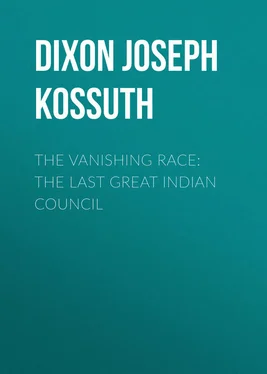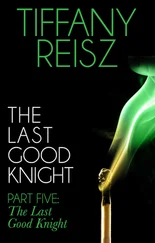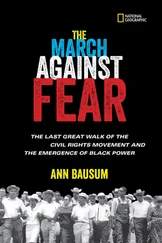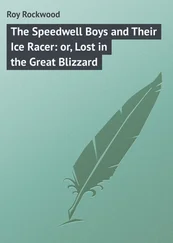Joseph Dixon - The Vanishing Race - The Last Great Indian Council
Здесь есть возможность читать онлайн «Joseph Dixon - The Vanishing Race - The Last Great Indian Council» — ознакомительный отрывок электронной книги совершенно бесплатно, а после прочтения отрывка купить полную версию. В некоторых случаях можно слушать аудио, скачать через торрент в формате fb2 и присутствует краткое содержание. Жанр: foreign_antique, foreign_prose, на английском языке. Описание произведения, (предисловие) а так же отзывы посетителей доступны на портале библиотеки ЛибКат.
- Название:The Vanishing Race: The Last Great Indian Council
- Автор:
- Жанр:
- Год:неизвестен
- ISBN:нет данных
- Рейтинг книги:5 / 5. Голосов: 1
-
Избранное:Добавить в избранное
- Отзывы:
-
Ваша оценка:
- 100
- 1
- 2
- 3
- 4
- 5
The Vanishing Race: The Last Great Indian Council: краткое содержание, описание и аннотация
Предлагаем к чтению аннотацию, описание, краткое содержание или предисловие (зависит от того, что написал сам автор книги «The Vanishing Race: The Last Great Indian Council»). Если вы не нашли необходимую информацию о книге — напишите в комментариях, мы постараемся отыскать её.
The Vanishing Race: The Last Great Indian Council — читать онлайн ознакомительный отрывок
Ниже представлен текст книги, разбитый по страницам. Система сохранения места последней прочитанной страницы, позволяет с удобством читать онлайн бесплатно книгу «The Vanishing Race: The Last Great Indian Council», без необходимости каждый раз заново искать на чём Вы остановились. Поставьте закладку, и сможете в любой момент перейти на страницу, на которой закончили чтение.
Интервал:
Закладка:
HIS ADORNMENT
To the casual observer the costume and character of the Indian all look alike. The mind is confused amid a riotous and fantastic display of colours. The fact is that the minor details of Indian dress are an index to Indian character and often tell the story of his position in the tribe, and surely tell the story of his individual conception of the life here, and what he hopes for in the life hereafter, and like the laurel wreath on the brow of the Grecian runner, they spell out for us his exploits and achievements. To the white man all these decorations are construed as a few silly ornaments, the indulgence of a feverish vanity, but they open like a book the life of the Indian. His motive in adornment is to mark individual, tribal, or ceremonial distinction. The use of paint on the face, hair, and body, both in colour and design, generally has reference to individual or clan beliefs, or it indicates relationship, or personal bereavement, or is an act of courtesy. It is always employed in ceremonies, religious and secular, and is an accompaniment of gala dress for the purpose of honouring a guest or to celebrate an occasion. The face of the dead was frequently painted in accordance with tribal or religious symbolism. Paint is also used on the faces of children and adults as a protection from wind and sun. Plucking the hair from the face and body is a part of the daily program. The male Indian never shaves and the beard is a disgrace. A pair of tweezers becomes his razor. Sweet grasses and seeds serve as a perfume. Ear ornaments are a mark of family thrift, wealth or distinction, and indicate honour shown to the wearer by his kindred.
Among the Plains Indians the milk teeth of the elk were the most costly adornments. They were fastened in rows on a woman's tunic and represented the climax of Indian fashion, the garment possessing a value of several hundred dollars. Head bands, armlets, bracelets, belts, necklaces, and garters of metal and seeds and embroidered buckskin were in constant use. They were not only decorative but often symbolic. Archaeological testimony tells of the almost general use of sea shells as necklace ornaments, which found their way into the interior by barter or as ceremonial gifts. The chiefs of the tribe were fond of wearing a disk cut from a conch-shell, and these were also prominent in religious rites, ranking among the modern tribes as did the turquoise among the people of the Southwest. A necklace of bear claws marks the man of distinction, and sometimes was worn as an armlet. In the buffalo country the women seldom ornamented their own robes, but embroidered those worn by the men. Sometimes a man painted his robe in accordance with a dream or pictured upon it a yearly record of his own deeds, or the prominent events of the tribe. Among the southern tribes a prayer rug was made on deer skin, both the buffalo and deer skins having been tanned and softened by the use of the brains taken from the skull of the animal. The skins were painted with intricate ornamentation, symbols and prayer thoughts adorning the skin in ceremonial colours; white clouds and white flowers, the sun god, and the curve of the moon with its germ of life, the morning star, and also a symbol of the messengers from the gods. Above it all zigzag lines ran through the blue of the sky to denote the lightning by which the children above sent their decrees to the earth children who roamed the plains.
Footgear often proclaimed the tribal relation, the peculiar cut and decoration of the moccasin denoting a man's tribe. The war-shirt was frequently ornamented to represent the life story of the man wearing it. The breast contained a prayer for protection, and on the back might be found woven in beaded tapestry the symbols of victory. He had conquered the trail behind him. The shirt was often decorated with a fringe of human hair, the more warlike appending the scalps of the slain. The warrior wore no regalia so imposing as his war-bonnet with its crown of golden eagle feathers. Before the coming of the horse the flap at the back rarely extended below the waist, but when the warriors came to be mounted, the ruff of feathers was so lengthened that when the Indian was dismounted it trailed on the ground. The making of a war-bonnet was accompanied by song and ceremony. Each feather before it was placed in position was held in the hand and had recounted over it the story of some war honour. A bonnet could not be made without the consent of all the warriors and it stood as a record of tribal valour and a special mark of distinction granted to the man by his tribe. Every Indian takes great joy in laying out his colour scheme. It becomes a mosaic of artistic talent. Feathers are gathered from the eagles' flight. Skins are taken from the wild beasts. Bones, beads, sparkling metals, soft-tinted sea shells, and all of them blended with the varicoloured paints that he has compounded in nature's mortar. The woman enters into the work with intelligent zest, and when completed the whole array of blended colours is beyond the criticism of the tribe. The back of an Indian's war-bonnet and war-shirt is always more gaudy and sumptuous than the front view and this because when Indians pass each other their salutation is brief and formal. They ride right on. But after the meeting they turn in the saddle and look back to take an inventory. The wealth of the Indian, his position in the tribe, his ceremonial attainment are all passed upon and estimate entered. This colour scheme goes on through the entire Indian wardrobe to pipe sack, coup stick and moccasins. The Indian could not have received his suggestion for a colour scheme from the tinted leaves of autumn for they are dull in comparison. He may have had a hint from the glowing sunsets that in that western land fill earth and sky with a glory so transcendent that mere rhetoric is a profanation. More likely is it that when free and unrestrained he roamed over plain and hill his soul became enamoured with the dazzling array of colours, beyond the genius of the proudest palette, to be found in the marvellous formations that surround the great geysers of the Yellowstone, colours more exquisitely beautiful than the supremest refinement of art. Every-whither down the cone-shaped mounds are tiny steam-heated rivulets interlacing each other, edged with gold and vermilion and turquoise and orange and opal. Indian trails have been found also interlacing each other all through this wonderland. Deep furrows in the grassy slopes of these ancient footprints are still plainly visible. Thither we may believe came the red man imbued with the spirit of reverence and awe before all this majesty and beauty, and from this exhaustless laboratory claimed the vivid colouring for the expression of his life of faith.
HIS WARFARE
The Indian has lived such a life of hazard for long centuries that he has had trained into him a first great instinct to fight. They have a war star in the sky, and when it moves the time to make war is heavy upon them. There are many cogent reasons for the belief that before the coming of the white man there were no general or long-continued wars among the Indians. There was no motive for war. Quarrels ensued when predatory tribes sought to filch women or horses. Strife was engendered on account of the distribution of buffalo, but these disturbances could not be dignified by the name of war. The country was large and the tribes were widely separated. Their war implements were of the crudest sort. A shield would stop a stone-headed arrow, and it necessitated a hand-to-hand conflict for the use of a flint-headed lance and the ponderous war club. The white man came, and for hundreds of years their contest has been waged against a superior force. They have disputed every mile of territory which has been acquired from them. During all that time they could not make a knife, a rifle or a round of ammunition. Their method of communication was confined to the smoke signal, signal fires and scouts. They had no telegraph, no heliograph, no arsenal. Modern implements of war they have been able to obtain only in late years and then in meagre quantities, even then only by capture or at exorbitant rates. The Indian has proved himself a redoubtable and masterful foe. For more than three hundred years millions of civilized white people have fought a bitter battle with three hundred thousand red men. During all these tragic years the nations of the world have moved on to discovery, subjugation, and conquest. Nation has taken up arms against nation. England, France, and Spain have put a rim of colonies about the globe. Our own great civil struggle has been written down on the pages of history with letters of blood. England, France, Spain, and the United States have during this period tried their prowess with these less than three hundred thousand braves and only now has the decimation become complete. No such striking example of endurance, power of resistance, and consummate generalship has been recorded in the annals of time. Sitting-Bull, Red Cloud, Looking-Glass, Chief Joseph, Two Moons, Grass, Rain-in-the-Face, American Horse, Spotted Tail, and Chief Gall are names that would add lustre to any military page in the world's history. Had they been leaders in any one of the great armies of the nation they would have ranked conspicuously as master captains. The Indian, deprived of the effectiveness of supplies and modern armament, found his strongest weapon in the oratory of the council lodge. Here, without any written or established code of laws, without the power of the press and the support of public sentiment, absolutely exiled from all communication with civilized resources, unaided and alone, their orators presented the affairs of the moment to the assembled tribe, swaying the minds and wills of their fellows into concerted and heroic action. The wonderful imagery of the Indian orator – an imagery born of his baptism into the spirit of nature – his love of his kind, and the deathless consciousness of the justice of his cause made his oratory more resistless than the rattle of Gatling guns, and also formed a model for civilized speech. It was an oratory that enabled a few scattering tribes to withstand the aggressions of four great nations of the world for a period of several centuries, and to successfully withstand the tramping columns of civilization. The science and art of Indian warfare would take volumes to compass. His strategy and statesmanship compelled victory. He was almost always assured of victory before he proceeded to battle. He knew no fear. A thousand lives would have been a small gift had he the power to lay them on the altar of his cause. He pitted the perfection of details against the wily strategy of his own colour and the pompous superiority of the white man's tactics. On the trail care was taken to cover up or obliterate his footprints. When a fire became necessary he burned fine dry twigs so that the burning of green boughs would not lift to the wind an odour of fire, nor carry a trail of smoke. He conceived and carried out a wonderful deception in dress. In winter a band of warriors were painted white. They rode white horses and their war dress was all of it made of the plainest white so that a group of warriors, stationed on the brow of a hill, would appear in the distance like a statuesque boulder clad in snow. This disguise also enabled them to come with stealthy step upon wild game. In autumn their horses were painted yellow and they wore a garb of yellow so that fringing the edge of the forest they could not be distinguished from the leaves of the dying year. The blue-green of the sagebrush, so conspicuously omnipresent on the prairies, furnished the Indian with another helpful form of disguise. He would almost completely disrobe and paint his face, his arms, and his hair, as well as the body of his horse, exactly the colour of the sagebrush; and when scouting, after their crouching fashion, among the clusters of sagebrush, or riding in the distance along the verdure-covered banks of a stream, the disguise would be so absolutely complete that detection became a difficult task. It was an ingenious and artistic display of war talent.
Читать дальшеИнтервал:
Закладка:
Похожие книги на «The Vanishing Race: The Last Great Indian Council»
Представляем Вашему вниманию похожие книги на «The Vanishing Race: The Last Great Indian Council» списком для выбора. Мы отобрали схожую по названию и смыслу литературу в надежде предоставить читателям больше вариантов отыскать новые, интересные, ещё непрочитанные произведения.
Обсуждение, отзывы о книге «The Vanishing Race: The Last Great Indian Council» и просто собственные мнения читателей. Оставьте ваши комментарии, напишите, что Вы думаете о произведении, его смысле или главных героях. Укажите что конкретно понравилось, а что нет, и почему Вы так считаете.












